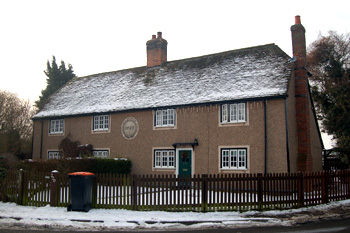
270 and 271 Bedford Road Christmas Eve 2010
270 and 271 Bedford Road were listed by English Heritage in May 1984 as Grade II, of special interest. According to a plaque this pair of cottages was built by Samuel Whitbread I in 1763 and restored in 1909. The pair has a pebble-dashed exterior over a timber frame and has a half-hipped roof composed of old clay tiles. Each cottage had two rooms upstairs and two down. A lean-to addition now stands at the rear.
We are fortunate that three surveys of the parish of Cardington from the late 18th century survive. The first of these was undertaken in 1782 by James Lilburne. He was the parish schoolmaster and later agent for Samuel Whitbread, who owned large estates in the parish and also the sole Enclosure Commissioner for the parish. He produced a list of all the inhabitants of the parish arranged by house and hamlet [P38/28/1/1]. This was published, with extensive analysis by County Archaeologist David Baker in 1973 as Bedfordshire Historical Record Society Volume 52.
Since publication a second list has been found [P38/28/1/2]. It carries revisions up to the year 1789. Sadly neither of these surveys includes a map. Finally, in 1794 Lilburne produced another survey [W2/6/1-3] and this one had a map with a key showing where each house was. One can use this to plot the houses of the previous surveys and this work was carried out by John Wood of Bedfordshire County Council’s Conservation Section in October 1982 [CRT130Cardington29].
The 1782 survey [P38/28/1/2] recorded that the occupants were William Tomas and Richard Brown. William Tomas was 46 years old, a labourer born in Sandy and a “dissenter” that is, a nonconformist in religion. His wife was 51 year old Mary, née Stock, who had also been born in Sandy. Their children were 19 year old Dinah who had been schooled courtesy of John Howard and now made lace and 13 year old Mary who also made lace and who sang. The family were not willing to be inoculated against smallpox. They moved to Willington Turnpike in 1785.
They were replaced on 14th May that year by Richard Brown, a 24 year old shoemaker who had been born in Cardington. Thus two Richard Browns lived next door to one another. He married 21 year old Elizabeth, née Richards, who had been born at Cople on the day he moved in. Both had had smallpox before May 1787. They did not stay long, moving to another cottage in the village in 1786. The new tenant was William Dynes, a 22 year old wheelwright who had been born at Old Warden. He was also a dissenter and willing to be inoculated against smallpox if others were. He married 28 year old Ann Fidging, from Potton, on 26th July 1787. She had had smallpox prior to May 1787. Dynes’ 18 year old apprentice Thomas lived with them. He was unwilling to be inoculated. The couple had a son, William, who was born on 28th November 1787. The following year they moved to 326 Church Lane where they were still resident in 1794 [W2/6/1-3].
Richard Brown’s family inhabited the other cottage in 1782. He was 49 and a bricklayer who had been born in Cardington. He had had smallpox prior to May 1787. His wife was 49 year old Catharine, née Thody who had also been born in the village, she made lace. She was unwilling to be inoculated against smallpox. They had four children: Catharine, aged 20, who made lace and in 1787 married a man in Meppershall, she had been schooled courtesy of Samuel Whitbread; Sarah, aged 18, she had been schooled courtesy of John Howard and made lace, in 1787 she went into service in Bedford; John, aged 11, who was schooled at his father’s expense and was apprenticed to him, his entry is annotated: “sings”; Richard, aged 9, who was schooled at the expense of John Howard and was also apprenticed to his father. Richard’s entry has the curious annotation: “has it in the natural way”.
Catharine junior, John and Richard were all willing to be inoculated against smallpox but Sarah was unwilling. The family moved to another cottage in the village in 1783.
The survey of 1794 has the occupants of the two houses as Thomas Braybrooks, who had moved from 273 Bedford Road in 1783 and Mary Preston and his family, who had moved from 326 Church Lane in 1788 [W2/6/1-3]
The Rating and Valuation Act 1925 specified that every building and piece of land in the country was to be assessed to determine its rateable value. Cardington, like most of the county, was assessed in 1927 and the valuer visiting 270 and 271 Bedford Road [DV1/C116/110-111] found them still owned by the Whitbread Estate.
270 Bedford Road was occupied by A. Clarke who paid rent of £2/3/3 per half year for a parlour, living room and two sculleries with two bedrooms above. 271 Bedford Road was in the occupation of J. Summerfield who paid rent of £3/18/- per half year for identical accommodation.